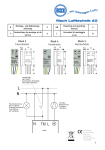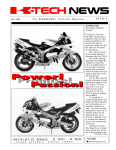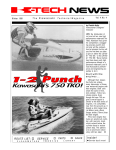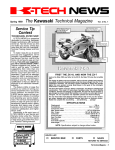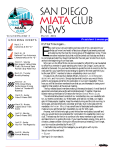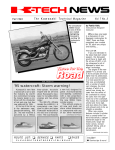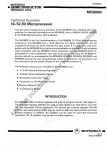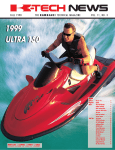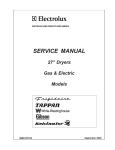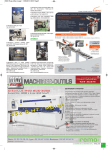Download K-Tech News Vol. 3 No. 4
Transcript
Winter 1990 The Kawasaki Technical Magazine Vol. 3 No. 4 Two bikes, one commitment! One brand-new Kawasaki ZX-7 for And, while you can hang a license 1991 would have been news. Two plate on the ZX750-K1: NINJA ZXnew-from-the-ground-up ZX-7s is 7R (above, right) too, it’s really absolutely incredible-Kawasaki is going to shine on the race track. In out to rule the 750 class, lock, stock, truth, the ZX-7R has just one misand barrel! sion in life: the Superbike ChamThe all-new ZX750-J1: NINJA pionship. ZX-7 (above, left) is aimed at the In the short time since its incepsport rider who wants the latest in tion, the ZX-7 has been engineered street bike technology. There’ll be from the ground up twice and no mistaking Kawasaki’s latest with redeveloped once. Now that’s comits eye-popping lime green, vivid mitment. blue, and brilliant white color For more, grab hold and turn the scheme. page. . . . ROUTE LIST: o P L E A S E SERVICE R E T U R NT O o PARTS S E R V I C E o SALES L I B R A R Y S H O P T A L K / T E C H N I C A L ZX-7 750 power: The engine of champions by Ray St. John Supervisor, Technical Writing What we find in the new Ninja ZX-7 and ZX-7R Kawasaki models is one 750cc engine in two forms: street and nearrace-ready. The basic design is all-new, with the cam chain on the right hand end of the engine (unlike the original Ninja and the Concours). Hollow camshafts ride in five bearings each: four plain bearings and one needle bearing at the sprocketend of the shaft. Finger followers, similar to the ZX-11 design, open the valves through tiny, ultra-lightweight adjustment shims. n Valve gear The valves have slender 4.5mm stems and 29mm (intake side) and 25mm (exhaust side) heads to let the engine breathe easily at high rpm. The small stems lighten the valves so much that only single valve springs are needed. Light valves and low spring pressures mean less horsepower lost to opening and closing the valves. The included angle between the valves is a mere 20°, allowing a high compression ratio (10.8:1 in the ZX-7, 11.5:1 in the ZX-7R) in a clean, compact combustion chamber. The valve duration on the latest ZX-7 is a very mild 260° for optimum midrange torque. The ZX-7R has 28° more duration on the intake side and 20° more on the exhaust for extended top-end power. Don’t be fooled by those numbers: the ZX-7 won’t have to apologize to anybody for lack of power. n Rings and liners The compression piston rings on both ’91 ZX-7s are 0.8mm thick, just like the ZX750-H2’s. The difference is that the rings have “barrel”-shaped faces and a beveled inner surface for better sealing at all engine speeds. The oil rings are 25 percent thinner than last year’s at 1.5mm. The cylinders, meanwhile, have dry liners in an open deck like the ZX600D engine. This design results in better cooling at the top of the cylinders where they are hottest and most likely to distort. The larger diameter cylinder liners have shorter skirts to allow the air in the crankcase to move freely from cylinder to cylinder as the pistons rise and fall. This cuts pumping losses and increases high rpm power notably. n Carburetion The ’91 ZX-7 has 38mm constant velocity carburetors like the ’90 model for good fuel mileage, low exhaust emissions, and superior driveability on the street. The R-model is equipped with Keihin FVKD 39mm TECHNICALITIES Suspension with 2.3mm thick walls Upside down forks are while the ZX-7 has 43mm the big news in front sus- tubes, 2.0mm thick. The Rpension today. And both model forks are unique in new ZX-7s have them. But having seven-way adjusthey don’t have the same table compression dampones. While they share ing. Both models have springing and damping threaded preload adjusters rates, the ZX-7R has and 12-way rebound damping adjustment. 41mm diameter tubes 2 l K-Tech News The rear suspension on both new bikes features gas-charged shocks and bottom linkage Uni-Trak. Rear suspension preload is infinitely adjustable, and rebound damping is fourway adjustable. The rear shock on the ZX-7R-only has a remote reservoir as well as 20-way adjustable compression damping. The swingarm looks a lot like the one on last year’s factory F-l racer. The axles and swingarm pivot are a generous 25mm in diameter for rigidity and hollow for light weight. - Ray St. John S H O P carbs with flat slides opened directly by the throttle linkage. They have no diaphragms or pistons, and when you twist the grip all the way, they are open! To meet emissions standards, the ZX-7R’s carbs come with some unique and interesting features (see sidebar). n Crank, drivetrain Moving the cam chain to one end of the crankshaft let Kawasaki’s engineers shorten the crank, decrease the distance between bearings, and reduce the diameter of the journals. It is lighter and more rigid than the ’90 model’s crank. The transmission shafts are spaced slightly farther apart in the new engine, allowing the gears to be larger in diameter and, thus, stronger. The primary drive gears are specially manufactured for strength and low noise. The clutch has eight friction and seven steel plates for increased heatand torque-handling capacity. The steel plates are knurled to prevent the clutch from sticking when the engine is cold, and the friction plates are radially grooved to allow good oil flow for clutch cooling. A magnesium cylinder head cover, pulser cover, and output sprocket cover contribute to overall weight reduction. Dual oil pumps in the lubrication system, one for the oil cooler and one for the engine and transmission, prevent oil pressure drop to critical engine parts. One engine in two forms sharing a single promise: performance! o T A L K / T E C H N I C A L TECHNICALITIES The Z-7R carb: ingenious and effective Setting the ’91 ZX750-K apart from the J-model 750 are its new Keihin CR flat slide carburetors. The J’s are 38mm CVKD versions of the constant velocity carburetor that has mixed fuel in just about every model of motorcycle produced in the last decade. The ZX-7R’s 39mm carbs are a cornplete departure from constant velocity types-more like a much updated version of the type used on the original Z-1 Kawasaki! Since the ZX-7R intake tract is angled up 47° from the horizontal, the slide would normally be tipped over 47° from the vertical. In this position, gravity and manifold vacuum work together to create lots of friction between the slide and the carb body. To counteract this, the slides are Teflon@ coated and angled in the carburetor body back toward the vertical. In addition, two rollers located on each side of the slide further reduce friction. The resulting reduction in effort to move the slides gives the rider very precise throttle control. An accelerator pump provides up-scale throttle response while maintaining low exhaust emissions. Fuel from the inter-carburetor fuel supply line passes through an external line to a shut-off solenoid, then on to the diaphragm-type accelerator pump. A link rod actuates the pump when the throttle bell crank rotates. Air, being lighter than fuel, accelerates away from the fuel when the throttle valve is quickly opened. When the air arrives at the combustion chamber, there is not enough fuel with it and a lean stumble or hesitation results. To combat this, Kawasaki engineers have included an accelerator pump which shoots a stream of fuel down each venturi toward the intake valves. This supplies an enriched fuel mixture that arrives at the combustion chamber with the air. The result? Ultra-smooth acceleration. Of course, if this extra shot of fuel should arrive at the combustion chamber when engine rpm is low or the throttle not open wide enough, an excessively rich mixture could occur sending hydrocarbon emissions sky high. To ensure that this is a cleanburning accelerator pump system, a digital igniter and throttle switch control fuel delivery. So, when the throttle is more than ¼-open and the engine is turning high enough rpms, the solenoid opens and fuel is available to the accelerator pump. When the rider twists the throttle quickly, the accelerator pump delivers the correct fuel ratio for smooth acceleration while limiting engine emissions. It’s ingenious. And its very, very effective! - Jerry Heil The Technical Magazine l 3 G U E S T Winter 1990 Vol. 3 No. 4 ©1990 Kawasaki Motors Corp., U.S.A. (KMC). All rights reserved. K-Tech News Staff S P O T American Watercraft Institute details by Don Church Manager, Service Training and Communications Dept. Publisher Kawasaki Tech Services Publications Manager Don Church Executive Editor Gary Herzog Editor-in-Chief Gregg Thompson Regional Editors North and East Fred DeHart Central and South Walter Rainwater West and Corporate Patrick Kelly Contributors Bob Ellison, Jerry Heil, Mike Jeffers, Tevis Moffett, John Porno, Steve Rice, Ray St. John, Mary Sola, Bill Zito Graphics/Production Graphic Art Gregg Thompson The American Watercraft Institute in Daytona Beach, Florida, offers a five week technical training program devoted solely to personal watercraft. This program, the only one of its kind in the country, divides 200 hours of instruction into 13 sections. Each section covers a different aspect of personal watercraft operation and repair. Approximately 30 percent of the instruction is in the classroom, with the other 70 percent providing hands-on experience. Class size is limited to a maximum of 20 students, enabling individualized instruction. The Institute currently has 20 personal watercraft from various manufacturers as training aids. The American Watercraft Institute is a division of the American Motorcycle Institute, and therefore benefits from AMl’s experience and many student services, including job placement. For more information, call or write: Copy Editor Pat Shibata Production Nickless Communications Published by Kawasaki. All suggestions become the property of KMC. Sending a service suggestion gives Kawasaki permission to publish and/or use it without further consideration. Specifications subject to change without notice. 4 l K-Tech News American Watercraft Institute 1445 Skytrooper Road Daytona Beach, FL 32114 (800) 874-0645 (904) 255-0295 (Fla. only) American Watercraft lnstitute graduates will profit from 200 hours of classroom and hands-on training. C O M M U N I C A T I O N S Microby “Micro” Mike Jeffers Parts Publications Specialist S ince we last spoke, I have received many phone calls concerning microfiche decks, microfiche subscriptions and microfiche equipment. While I am delighted to answer these calls, it has occurred to me that many of you do not realize you already possess this information. Periodically the Technical Publications department at KMC, in conjunction with Micro-K, publishes “parts bulletins.” Copies are then mailed to the dealer network. Some of these bulletins explain in detail the Micro-K functions noted above: n The Micro-K parts microfiche deck and subscription policies are explained in detail in Parts Bulletin General 89-01 (issued Jan. 6, 1989). The details of parts microfiche decks and subscription prices, deck/subscription options and billing cycles are also explained in full. n Parts Bulletin General 89-03 (“Understanding the Microfiche Title Strip,” issued Dec. 9, 1989) instructs the novice parts or service technician in selecting the proper parts microfiche by using the information included in the title strip. n Parts Bulletin General 90-01 (“Microfiche Viewers and Accessories,” issued Oct. 5, 1990), lists Micro-K equipment available, fully explains the features and benefits of each piece of equipment, and notes dealer cost at time of print. Included in this bulletin is a list of spare maintenance parts and all accessories available from KMC. n As you may or may not know, the parts microfiche did not include replacement decals for motorcycles prior to 1988. Parts Bulletin MC 90-01 (issued Apr. 27, 1990) has a list of street-legal motorcycle decals categorized by model, year and decal description. New training video: “Watercraft Powertrains” by Ray St. John Supervisor, Technical Writing A new technical training video has just been released:® “Watercraft Powertrains” covers Kawasaki’s JET SKI watercraft powertrains from coupler to impeller. This 23 minute tape contains a wealth of information any technician will find valuable. For example, it explains why different boats have different drive shafts and different drive shaft bearing holders; why sealing the pump case to the hull is so important; and how the water jet propulsion system differs from simple propellers. For those dealers who have signed onto the automatic training video tape distribution system, this video has probably already shown up in your store (if you carry Kawasaki watercraft or are eligible to buy Kawasaki watercraft parts). As usual, your parts account will be billed at 30 percent off the regular dealer cost of $35.95 plus shipping and handling (and appropriate sales taxes, if any). If you’d like to take advantage of the money saving automatic training tape distribution system, give Kawasaki Technical Services Department a call at (714) 770-0400, ext. 2472. Ask for Pat Shibata and you’re in business. You’ll receive up to four new training tapes every year (but no more than four). Each tape will pertain to your product mix; you won’t get anything you can’t use. Of course, if you don’t like a tape, let us know and we’ll buy it back from you. And, if that still isn’t enough, all of Kawasaki’s other technical training tapes will be available to automatic subscribers at 30 percent off the usual dealer cost. o n An updated and easy to use Special Tool Catalog Hot Line Champion! microfiche should be at your dealership by the time you receive this issue of K-Tech News. The catalog lists special tools currently available through the ’90 model year. Congratulations to Hot n I would like to mention once more some of the new additions to the parts microfiche. To help simplify parts ordering and to lessen the research time needed for crash estimates, Kawasaki has added the Color Combination Parts List to row A on many of the motorcycle parts microfiche. Simply turn to the correct list by using these three indicators found on each list: Model designation, color scheme and V.I.N. (Vehicle Identification Number). Each painted (cosmetic) part will be listed and a part lumber given. One thing to keep in mind is that the “O” indicates the part number is applicable for the market region indicated, whereas the “X” means it is non-applicable. o Line staff member (and regular K-Tech News contributor) Steve Rice for winning the Dragbike U.S.A. 1990 OHC Funnybike Championship. The ’90 championship was determined in Gainesville, Fla., at the last points ‘ace of the year. While winning both the meet and the series title, Steve also set a new record in his class for top speed at 181.81 mph. Steve owns, tunes and rides the bike which is powered by a turbocharged, alcohol-burning, 1260cc Kawasaki engine. Enjoy the #1 plate, Steve, and more power to ya! - Ed. The Technical Magazine l 5 T I P S F R O M T H E Fighting dirt, fighting dirty by Steve Rice Product Support Specialist The internal combustion engine was never intended to run on dirt. The finest dust is incredibly abrasive and damaging in the top end of any engine. In four-stroke engines, it can work its way past the rings and collect in the through cracks in any of the rubber parts. Air cleaner service for off-road vehicles should always include a careful inspection of the intake connections and clamps. And be sure to grease the foam seal on the back of the filter element generously to ensure a perfect seal against the air S P E C I A L I S T S Check those fasteners! Don’t forget to check nuts, bolts and fasteners during the predelivery service on each and every vehicle you sell. Your dealership is responsible to make sure things don’t fall off the vehicle between delivery of a new unit and the first scheduled service. Among the hardware you should not overlook are those securing handlebars, fairing parts, suspension components, brake components, axles, footpegs, mufflers, and handrails. - Gregg Thompson Mule 1000 intake kit If your Mule 1000 customers are finding that, in condi- crankcase oil, damaging the bottom end as well. How do dirt and dust get into the intake tract? There are several potential sources. The air filter, of course, is designed to pass air with as little resistance as possible without passing any dirt. Today’s air filters normally do a very good job of this. But, as the filter collects dirt, it restricts air flow more and more. As the restriction increases, the air begins to find other ways to get in and all of them are downstream of the air filter. As the air leaks past the various connections in the intake tract downstream of the filter, it carries fine dirt with it. Dirt comes in through loose, worn, or misassembled connections, and/or 6 l K-TechNews box. Kawasaki’s Marine Grease (P/N W61080016) is excellent for this. Sealing all the connectors in the intake system with Kawasaki Bond (P/N 56019-120) greatly reduces the chances of dirt getting past them. Kawasaki Bond is not affected by the gas and oil present in the intake tract, and remains pliable enough that it won’t crack from vibration. Before sealing the intake tract connections, it’s best to completely disassemble and clean all the parts first, sealing with Kawasaki Bond on reassembly. Dirt is an enemy of all internal combustion engines. But with only a little extra attention, it’s easy to win the battle. o tions of extreme dust, their air filters require more frequent servicing than normal, this will help: An optional improved air intake system is now available for the Mule 1000. By adding a “snorkel” to the intake system, air can be drawn from the relatively dust-free environment above the cab frame rather than the floor areas as originally equipped. The installation of this new intake kit will extend the air filter’s service frequency in extreme operating conditions. Because of the snorkel’s length and diameter, the carburetors must be re-jetted to lean the mixture. The intake kit (P/N 99995-1222) contains all parts necessary to make the conversion, including the jets and needles for the carburetors. Dealer cost for the kit is $107.97. Complete installation, including re-jetting, should take less than an hour. - David Corey T I P S F R O M T H E Don’t forget those spokes In today’s high tech world of motorcycles, wire spoke wheels are becoming rare, if not a thing of the past. Because of this, they are sometimes overlooked. It is very important to check spoke tightness at pre-delivery set-up and at normal service intervals. Bikes ridden off -road should be checked every time out and especially after the initial break-in ride. This will prevent excessive wheel runout and subsequent damage to the rim or to the hub. When tightening spokes, always use the proper size wrench and go around the rim, turning each spoke nipple a small amount. Keep doing this, going around the rim, until all the spokes are snug. This will help keep the rim aligned and concentric with the hub. - John Porno Careful with the camchain H ere’s a tip for the next time you take the cams out of a ZX600, ZG1200 or ZN1300 engine: Always have the vehicle or engine vertical (straight up and down) when the camchain has slack in it. There is a small cast boss in the bottom crankcase just below the crankshaft camchain sprocket. This boss is designed to keep the chain from climbing over the sprocket teeth while the engine is running. However, if the engine is leaned to one side-as when the bike is on the sidestand-with the cams out, it is possible for the chain to sneak out from between that boss and the sprocket. If that happens, it’s almost impossible to get the chain back onto the sprocket without dropping the pan. - Gregg Thompson S P E C I A L I S T S What’s wrong with this picture? by Gregg Thompson Sr. Product Suppoff Specialist I f you find yourself faced with a cracked Kawasaki watercraft hull that needs to be repaired under warranty, the first thing you should do is call the Hot Line. The Hot Line technician will probably ask you to take some pictures of the damage and send them with a written estimate for inspection. But taking good pictures of a crack in a nice white hull can be a little tricky. A large percentage of the photos we receive don’t serve any purpose because they don’t clearly show the damage. Most often the photos are either out of focus or over-exposed. Here are some suggestions for taking better pictures that will allow us to see the damage: n Take the pictures in a well lighted area, preferably outdoors but not in direct sunlight. Direct sunlight is too bright and the photo of the hull will be overexposed, the crack washed out completely by the reflective white hull. It’s best to take the picture on a sunny day in the shade of a building. n Don’t use a flash. Like the sun, a camera flash reflecting off the glossy white hull will overexpose the area you’re trying to show. n Increase the visibility of the crack. Rub some charcoal or graphite (pencil lead) into the crack. Then wipe with a clean cloth. The char: coal will wipe right off the paint, but stay in the fibers of the cracked area. n Make sure your pictures are in focus. If you’re using a Polaroid camera, don’t get too close! Most Polaroid cameras won’t focus any closer than about three feet or so. The same holds true for many “point and shoot” auto focus 35mm cameras. Check on the lens bezel or look in the owner’s manual to find the minimum distance for your camera. n Remember, if you take a picture that doesn’t clearly show the damage, don’t send it. Take another one. We can’t make a decision about warranty authorization if we can’t see the problem. o The Technical Magazine l 7 T I P S F R O M T H E High tech valve seats The Technical Hotline staff was recently introduced to a new high tech method for cutting valve seats, and we would like to pass this information on to you. This tool may be especially interesting to those shops that do a lot of cylinder head work or high performance work. Representatives from the Serdi Corporation demonstrated a new high tech method of cutting valve seats in four stroke engines. The Serdi “Micro” is a new seat-cutting tool that will cut all the valve angles in one operation with its unique cutting tip. The work spindle that holds the cutter is adjustable to accommodate any valve angle, and it can cut seats from 14mm to 48mm. The inexpensive replaceable cutter tips can be ordered in any angle or width desired. Serdi offers several kits tailored to your needs and budget. If you have any questions about the Serdi Micro, please contact Ben Peccoux at the Serdi Corporation, telephone (404)493-8220. - J. Nowocinski If your shop has a lot of high performance business, check out this new high-tech valve-seat cutting tool from the Serdi Corp. forget to recommend gasoline stabilizer to all of your customers who are storing their motorcycles or watercraft for the winter. If your shop is preparing a customer’s vehicle for storage, be sure to run the vehicle long enough to get the 8 l K-Tech News Save a taper by Gregg Thompson Sr. Product Support Specialist Have you ever thrown away a crankshaft because there was some fretting (metal transfer) on the flywheel taper and you couldn’t get the flywheel to stay on? In fact, any damage to the tapers of the crankshaft or flywheel will reduce the “grip” when the parts are bolted together. However, the parts can often be saved, even though this kind of damage has occurred. The trick is to remove any high spots from both tapers and then lap both parts together. Use a flat file or hand grinder to remove the high spots where metal has trans- Before you store for winter. . . Don’t S P E C I A L I S T S treated fuel from the fuel tank into the carburetor(s) and fuel lines. It speeds things up to drain the float bowls before doing this. Kawasaki sells a stabilizer called “STA-BIL.” The part number is 1104. - Gregg Thompson ferred from one taper to the other. Be careful not to remove any metal from the undamaged portions of the taper. Once the high spots are gone, the two tapers can be lapped together for a perfect fit. Put lapping compound on the crank taper and spin the flywheel against it while applying pressure. Clean the compound off frequently and check the fit. The dull grey areas on the tapers are the places making good contact. The more contact, the better the grip. A fairly common misconception is that the woodruff key is supposed to keep the flywheel from spinning. In fact, the key is normally there just for timing purposes. It’s the taper that holds the flywheel in place. Lapping the flywheel to the crank ensures the best possible fit. Even when both parts are new, it’s not a bad idea to lap the tapers quickly to check the fit. And, when one part is new and the other is used, the tapers should be lapped together even if there is no damage visible on the old part. o T I P S F R O M T H E Voyager “sound tips” When a Voyager customer comes to you with a mangled and shredded cassette tape in his hand complaining about his “tape-eating cassette deck,” don’t replace the deck without first cleaning it. Clarion has reported to us that a large percentage of the cassette decks returned to them for repairs needed nothing more than cleaning, There are lots of cassette head cleaning tapes available in just about any store that sells blank tapes. You should have one in your shop and recommend that your customers buy one, too. Because of the Voyager tape decks location (it’s out there in the breeze), it needs cleaning a lot more frequently than a home or car stereo unit. Frequent cleaning will extend the life of the tape head and other internal parts, and will greatly reduce the chance that a deck will “eat” the customer’s favorite tape. Incidentally, Clarion has also reported that many “dead” radios are being replaced when they needed only a fuse. The Voyager XII radio has two inline fuses that should be checked any time the unit fails to come on or doesn’t light up. The fuses are located inside the fairing behind the headlight. The Voyager 1300 does not have these fuses. - Bob Ellison Twist lock plugs The Kawasaki GE4000 and GE4500 series generators have one 240v and one 120v twist lock-type outlet. The matching twist lock plugs do not come standard with the generator. They are, however, available from your local electrical supply store. The NEMA designation for the appropriate twist lock plug is embossed on the front of each of these outlets. The 240v four-prong outlet uses an L14-20 plug and the 120v three-prong outlet uses an L5-30 plug. - Gregg Thompson S P E C I A L I S T S NO muss, no fuss, no maintenance. . . by Jerry Heil Training Development Coordinator New to Kawasaki motorcycles this year is the Maintenance Free Battery which can be found on both ’91 ZX-7 models and the 750 Zephyr. “Mainfree” tenance means just that, with only a few special considerations. The electrolyte solution in an ordinary battery releases oxygen and hydrogen gasses readily at normal charging and discharging rates. A vent is required to prevent pressures that could crack the battery case. The vent, of course, allows the gasses to escape and water must be added occasionally to maintain the proper electrolyte dilution and fluid level. The electrolyte solution in a maintenance free battery releases gasses at a much slower rate. Under normal conditions, the battery doesn’t vent at all and the gasses are absorbed back into the electrolyte. You must be careful, however, not to charge the battery at too high a rate. There is a pressure relief valve in the battery which will vent gasses when pressures get too high, but fluid that has been lost this way cannot be replaced. In storage, the maintenance free battery discharges internally at a much slower rate. At room temperature, a conventional battery will drop from a full charge to 70 percent charge in about 2-1/2 months. The same drop in charge with a maintenance free battery takes almost six months! Initial servicing of a new Yuasa maintenance free battery is pretty slick. The electrolyte for these batteries is supplied in a special container. When inverted and pushed into the filler openings, the container automatically dispenses the fluid into the battery with no spilling and no mess. DO NOT puncture or remove the foil seals on the electrolyte container. They are pierced automatically as you push the container down into the filler ports in the battery. To seal the battery, push the cap strip down into the filler ports until the strip is flush with the top of the battery. After 10 minutes, check the battery voltage. If it is below 12.5v, charge the battery at 1-1.5A for two to five hours before putting it into use. If it is below 11.5v, charge it for at least 10 hours. o The Technical Magazine l 9 T I P S Is it premix or is it straight? Have you ever wondered if that gas can over there (or that customer’s JET SKI® watercraft) has premix or straight fuel in it? You smelled it, poured some in a glass to check the color, dipped your fingers in it and you still weren’t sure? F R O M T H E S P E C I A L I S T S Attention service managers! In order for us to process your warranty claims quickly and efficiently, we need you to completely and legibly fill out all the appropriate blanks on the claim form. The following is a list of the problems we most often see on warranty claims: n Dealer number is omitted or incorrect. n Failure and repair dates are omitted. (These are required on all claims. The failure date is the day the customer first notified you of the problem.) n Purchase date omitted on claim types 4 and 5. (Spare part and accessory claims must include a purchase date.) n Claim type omitted or incorrect. n Inadequate or incomplete description. (Make sure your description clearly and completely explains both the trouble—vehicle symptoms or customer complaint-and the cause-the defect or failure that produced the symptoms. Also, describe what you did to fix it.) n No repair order included with Extended Coverage claims. (All Extended Coverage claims must have a copy of your service department repair order attached.) You’ll notice that this list is dominated by the word “omitted.” Most of the problems we encounter on warranty claims involve missing information. Please review each claim before sending it in and remember that fewer errors on claims will result in faster payments to you. Thanks! - Warranty Claims Department Police motorcycles: front fork service Well, you might want to try this: Take a strip of plain white paper, like typing paper, and dip it into the fuel in question. Then dip another strip into some gasoline you know is “straight.” After both strips have dried, you will be able to see a slight difference between the two if the questionable gas is premix. The oil in the premixed gas will not evaporate and it will leave the paper looking slightly damp and discolored. The more oil there is in the gas, the greater the difference between the two strips of paper. - Tevis Moffett 10 l K-Tech News by Bill Zito, National Police Motorcycle Coordinator One of the most overlooked components during routine service is the front fork assembly and the fluid contained inside the fork tubes. This fluid serves two very important functions: First, it provides viscous hydraulic damping; second, it puts a lubricating film between moving parts within the fork assembly. This fluid becomes contaminated with use and loses its ability to provide proper hydraulic damping. The recommended change interval for the Kawasaki Police 1000 motorcycle is every 6,000 miles. When changing the fluid, it is important that the proper type, viscosity, and quantity of fluid is used in each fork assembly. Always use fork or suspension fluid; never use engine oil, automatic transmission oil, or hydraulic oil. Refer to the Kawasaki service manual for the particular year model motorcycle you are working on to determine viscosity and amount of fluid. When checking the overall fluid level, it is best to measure the level of fluid in each tube. On the KZ1000 P-series motorcycles, this is done with the fork springs removed and the forks fully compressed. You measure from the top of the fork tube to the top of the oil. The level must be the same in both tubes. MODEL LEVEL KZ1000-P1~P4 170 ± 2mm KZ1000-P5~P10 157 ± 2mm The front fork assembly is one of many systems on motorcycles that affects rider control. And, as with other systems, the forks require attention at specific intervals. If you have any questions about the front fork assembly or other systems on the motorcycle, always refer to the shop manual. o T I P S F R O M T H E WEST CONTlNUED FROM PAGE 12 lights. Replace the faded old banners and posters on the wails with some new ones. And don’t forget about the shop equipment; it could probably use some maintenance and cleaning up, too. Winter is a great time to analyze the service department layout. Is it as efficient as it could be? Are related pieces of equipment, such as the tire machine and the tire balancer, placed in the same area? Are all resource materials, such as microfiche viewer and service manuals, located close together? An efficient layout will help make the service shop more productive when the pace of service work accelerates in the spring. All too soon, it’ll be that time of year again! o SOUTH & CENTRAL CONTINUED FROM PAGE 12 outlined in a contrasting color, you’ll have an impressive display and have a way to keep track of those expensive items. And, after painting the peg board, you’ll surely be motivated to paint the rest of the service department! Look around; there is plenty of work to be done-a lot that should have been done much sooner. Self-motivation will get the work accomplished. Like it says in those great Nike shoe ads, “Just do it!” o NORTH & EAST CONTINUED FROM PAGE 12 regular chance to review service training schedules, please check with your Service Manager or perhaps the dealership’s Sales Department. Can’t find the training schedule anywhere? Then do contact your regional sales off ice and we will send one to you. Don’t forget to keep in touch. I hope to speak with you soon at one of our classes! o S P E C I A L I S T S Customer Service: The Series! GE does It, Nordstrom does It, and many Kawasaki dealers, small and large, do It, too. What is “It?” Provide excellent customer service. And, while “customer service” may have been just business buzzwords for the ’80s, genine good service will be the underlying concept and practice for every successful operation in the ’90s. No longer is it enough just to give good customer service; only exceptional service will gain and keep customers. As you know, keeping customers is the key to surviving in today’s economic climate. OK, you’ve gotten the idea that service is a good deal for you as well as being good for your customers. Where do you go from there? What are the most important elements in providing customer service? How do you move from good to excellent? And how do you handle the customer who makes you wonder why you ever got into this business in the first place? Good questions, and ones we’ll be trying to answer in the next few issues of K-Tech News. n We’ll start with attitude: “Attitude” is probably the single most important factor in delivering customer service excellence. That “we’re here to help” mentality must come from the store’s owner and it must be shared by everyone who works in the shop, no matter how much or how little direct contact with customers he or she may have. All of the store’s employees have to work together all of the time to solve problems and provide service. When everyone thinks of him/herself as being on the customer’s side, ideas for delivering great customer service seem to come more easily. Suddenly, handling that difficult customer isn’t as hard as it used to be either. (In fact, you’ll probably find that there are fewer of them.) Exceptional customer service starts with the idea that service is the store’s main product and the single most important item the shop has to offer. In future issues, we’ll try to offer some specific ideas, tips and strategies for helping you to help your customers. Stay tuned. - Mary Sola Primer Bulb If you have a 650 Tandem Sport customer complaining of hard starting, be sure to ask him if he is using the primer bulb before starting. Actually it would be a good idea to tell all your Tandem Sport customers that any time the vehicle has not been run for a day or more, a few squeezes of the primer bulb before the first start up will ensure quick and easy starting. This is one of those little pieces of information that can save a lot of aggravation. - Gregg Thompson The Technical Magazine l 11 R E G I O N A L N E W S Training Schedule East Region December 4-7 11-12 13 18 Engines Fuel Systems High Performance Engines Service Department Operations (K-BOSS) 19-20 ATV Service January 3-4 Fuel Systems 8-11 Engines 22-24 JET SKI® Watercraft High Performance Engines 29 30-31 Troubleshooting Electrical Systems North Region January Service Department Operations (K-BOSS) 16-17 Team Green Race Preparation High Perf. JET SKI ® Watercraft 18 15 WEST SOUTH & CENTRAL NORTH & EAST It’s that time of year Motivation: Just do it! I’m still getting calls! by Patrick Kelly by Walter Rainwater by Fred DeHart 9950 Jeronimo Road Irvine, CA 92718 (714) 770-0400 6110 Boat Rock Blvd. S.W. Atlanta, GA 30378 (404) 349-2000 201 Circle Drive N., #107 Piscataway, NJ 08854 (201) 469-1221 It’s that time of year when Are you a self-motivator? It’s late November as I the volume of work flowing into the service department slows to a reasonable level. In fact, in some cases, it becomes what a few dealers call the “slow season,” the perfect time to enjoy being caught up with all of the service work and “take a breather.” I think, however, that most people out here in the west think of this as the “catch up” season. It’s a good time to do all the things you’ve wanted to do around the service department all summer but have simply been too busy to tackle. For starters, how about sprucing up the place. After a long busy season, your service area could probably use it. Splash some fresh paint on the walls. Hang some more Do you have difficulty keeping busy? Well, as my West Region colleague Patrick Kelly writes (see his column at left), now really is the time of year to become motivated and do all the things around the shop you said you’d do when you could get the time! Straighten up your service department and recover some lost space. Repair those trade-ins and get them ready for sale. Throw away the real old junkers (or, at the very least, cover them up). Here’s a tip that will help you improve the professional appearance of your service department: Hang all of your special tools on a single, painted sheet of peg board. With the tools write this, and I am still getting numerous calls from mechanics asking for copies of our training schedule! As most of you know, Kawasaki’s Technical Services Department mails an updated training schedule to your dealership every month starting in late September. This mailer lists the class selections for all regions, and generally covers a twomonth span. For instance, your dealership should recently have received the schedule of training classes in January and February 1991. Technical Training classes are also listed on the back page of K-Tech News, so if you haven’t seen a schedule recently, look to your right. If you aren’t getting a CONTlNUED ON PAGE 11 12 l K-Tech News CONTlNUED ON PAGE 11 CONTINUED ON PAGE 11 Central Region January/February High Performance Engines 28 29-1 Engines South Region December 3-5 JET SKI® Watercraft High Performance Engines 10 11-14 Engines 17-20 Troubleshooting Electrical System: January 7-9 JET SKI® Watercraft 14-15 ATV Service Service Department Operations 16 (K-BOSS) 17 Generator 21-24 Engines West Region December 10-11 Troubleshooting Electrical System! 12 Generators Voyager Familiarization 13 17-19 JET SKI® Watercraft Service Department Operations 20 (K-BOSS) January Shaft Drive ATV Service JET SKI® Watercraft Generator Team Green Race Preparation Fuel Systems Service Department Operations (K-BOSS) 28-30 Police Motorcycle Maintenance 3 4 7-9 10 14-15 16-17 24












